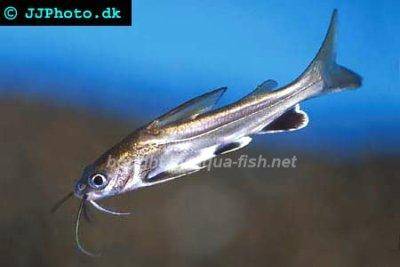Shark catfish - Hexanematichthys seemanni
Scientific name: Hexanematichthys seemanni
Common name: Shark catfish
Family: Ariidae
Usual size in fish tanks: 30 - 35 cm (11.81 - 13.78 inch)
014
Recommended pH range: 6.8 - 8
Recommended water hardness: 8 - 30°N (142.86 - 535.71ppm)
0°C 32°F30°C 86°F
Recommended temperature range: 22 - 26 °C (71.6 - 78.8°F)
The way how these fish reproduce: Spawning
Where the species comes from: Central America
Temperament to its own species: peaceful
Temperament toward other fish species: peaceful
Usual place in the tank: Bottom levels
Origin
The Shark Catfish is native to Central and South America. It lives in coastal river systems, where it frequently moves between brackish and freshwater environments.
Short Description
This species of fish is commonly known by various names, such as the Columbian Shark, Silver-Tipped Shark, and West American Cat Shark. Often sold as juveniles in pet stores, they are delicate and frequently kept in unsuitable conditions due to poor advice, leading to a short lifespan in home aquariums. When properly cared for, adults can grow quite large, with mature males reaching up to 20 inches (~50 cm) in length, though many remain smaller. It’s important to provide a spacious aquarium to accommodate their growth. They have a stunning silver body that can change in appearance depending on lighting. Known for their peaceful nature, they can be kept with other species of similar temperament.
Lifespan
With proper care, Shark catfish typically live for at least 10 years. Some individuals can live even longer, well beyond this average lifespan.
General Care
The Shark catfish is a delicate species and should not be introduced to an immature aquarium setup. It is crucial to acclimate them slowly to avoid shock from sudden changes in water parameters. The minimum tank size for a single adult Shark catfish should be at least 75 gallons (~90.07 US gallons, 341.91 liters). If keeping more than one, increase the tank size accordingly. These fish need plenty of swimming space, so thorough research is essential before purchasing, as they are not ideal for novice aquarists. Juvenile Shark catfish in the wild are raised in brackish water, making them less suited for a purely freshwater environment, though adults adapt better. Maintain a water temperature between 22-26°C (72-79°F) and a pH level between 6.8-8.0. Use sand as the substrate, with coral sand helping to stabilize the pH. While decorations are optional, ensure ample open space at the bottom of the aquarium for swimming.
They can be housed with other species of a peaceful disposition, but avoid keeping them with smaller fish, as these may be perceived as potential food sources.
The shark catfish will develop spines on their dorsal fins, so exercise care when handling them or performing tank maintenance.
Feeding
Shark catfish often spend a lot of time near the substrate searching for food scraps, though some keepers have observed them feeding from the water's surface as well. They will readily accept sinking pellets and high-quality flakes. It is beneficial to supplement their diet with live or frozen foods, such as bloodworms, chopped cockles, or brine shrimp.
Sexing
There are no noticeable physical differences between male and female shark catfish when they are juveniles. However, as they mature, females will develop lighter-colored fins compared to the darker fins of mature males.
Breeding
Breeding shark catfish can be very challenging unless you are a specialized breeder. The main difficulty is that young juveniles need brackish water conditions, while adults gradually adapt to freshwater environments. Shark catfish are paternal mouthbrooders, meaning the female lays only a few eggs per spawn. The male then incubates these eggs in his mouth and takes care of the fry once they hatch.
Pictures
Bought by aqua-fish.net from jjphoto.dk




 Salmontail
Salmontail  Jordans
Jordans